This is a Veteran Owned site

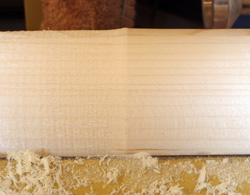 |
The soft nature of pine along with its low price makes it valuable to me on the lathe. |
Practice Turning with Pine
Very cheap and surprisingly instructive
Text, photos and video by Tom Hintz
Posted – 2-3-2011
A frequent question that I get at NewWoodworker.com is from new (and veteran) woodturners that are looking for cheap wood with which to practice. There are some who believe pine is just junk wood and with a consistency that is of no use on a lathe. But there are others, including myself who turned a bunch of pine early in our turning lives and found it a great material for learning the use of the basic chisels. And, beyond that initial practicing pine can have other cost-saving uses in the average shop.
Softer Density
It is true that pine is considerably less dense than most hardwoods but that can work in your favor, particularly if you are new to turning. Catches, where the chisel grabs the wood and tries to plunge into it deeply are a fact of life in turning but more so early in the learning process. In hardwoods these catches can be violent and potentially dangerous. In pine the chisel has a much better chance of tearing through more of the wood which reduces the initial impact of a catch. However, don’t let that make you brave. If you have the chisel and or your fingers in the wrong place a catch in pine is going to hurt in a big way and still has the potential to be dangerous. With pine the severity of those types of events can be reduced to some degree, not eliminated. You still have to learn to use a lathe and related equipment safely.
When using a chuck the relative softness of pine can make it necessary to re tighten its jaws a time or two. The wood will compress a bit and your pressure with tools on the wood can enhance this. The same kind of compression can happen with many hardwoods as well but to a lesser degree. It is a good idea to stop turning occasionally and snug up the chuck. If you start getting a vibration or any other noise that just sounds different, stop the lathe and check the mounting right away. You may also find the tailstock center has sunk in a bit and needs to be tightened on the stock a bit.
Fray – No Fray
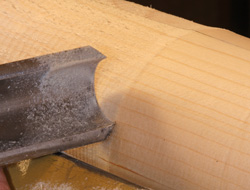 |
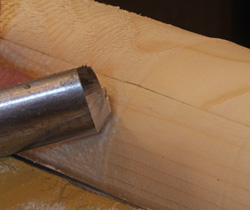 |
The soft nature of pine shows itself immediately when you cut with the edge (left) rather than the bevel (right). That instantly visible indicator makes learning to ride the bevel - a critical skill in turning - very easy and very fast. Not to mention cheap! Click images to enlarge |
|
One of the core skills in turning is learning to “ride the bevel” to get the finest finish possible right off of the tool. Get this right and you can eliminate lots of sanding. Get it wrong and you may become the favorite son of the sandpaper makers.
When using pine for learning the difference between riding the bevel and not riding the bevel is readily visible, often without stopping the lathe. The fragile pine fibers fray badly when only the cutting edge of the chisel is being used. Without the bevel being in contact with the wood the cutting edge can tear its way through the wood and while it can remove lots of material quickly it also leaves a badly frayed surface.
When you get the angle of the chisel just right the bevel rubs on the wood as the cutting edge shaves material off. With the bevel rubbing the depth of cut is more controlled and that lets the cutting edge do more slicing than tearing. Also, the rubbing of the bevel essentially burnishes the pine. Between the cutting edge slicing cleanly with the bevel rubbing at the same time the results can be a surface that is literally shiny. If you have decent lighting around your lathe you can actually see the shine developing while turning. Of course you may also notice the dull, fuzzy appearance of the wood just as quickly when you don’t have the bevel rubbing.
This fuzzy/shiny effect does happen with hardwoods but usually to a lesser degree. And because the grain is generally much tighter in hardwoods sanding the sections of upset grain out can be a little easier (not always) than sanding the same problem out pine might be.
Economy of Scale
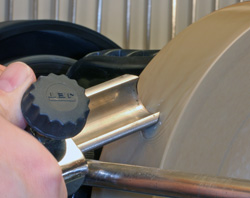 |
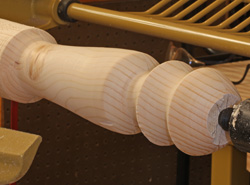 |
The fragile nature of pine requires using sharp tools. (left) Another easy to see lesson when your tools go dull. the cheap cost along with easy glue ups make pine great for prototyping (right) projects before committing to expensive hardwoods., Click images to enlarge |
|
With modern wood glues you can glue up pieces of common 2X4 material to make turning blanks whatever size that you need. I made use of every 2X4 I had in my shop when I brought my first lathe home. Then I made frequent trips to the local big box store for more, especially when they had sales on 8-foot 2X4 for $3 each! As with any glue up on the lathe, be sure to get a solid glue surface and let the glue dry completely before turning!
I also have used pine glue ups to test an idea before committing a design to hardwood. Besides getting a better idea of how an idea will look in full size I am often able to identify problem areas in the turning process on the way to that shape. On more than one occasion that experience allowed me to modify the shape or come up with a better way to turn it before encountering that problem with expensive wood in the lathe. This kind of discovery in pine can represent a substantial savings in wasted money and time.
Your Homework
If you are looking to improve your skills with turning chisels and to do it in a less costly manner, using pine can be a very good alternative to more costly woods. Eventually you want to practice these same skills on hardwoods but learning how to present the bevel correctly on pine first will save a bunch of wood money. Once you get the feel of riding the bevel that technique applies directly to any type of wood including expensive hardwoods.
Video Tutor |
Remember that using pine is not a free pass. You still have to prepare the wood properly, look for defects that could cause it to break while turning and your tools need to be just as sharp as when used on the expensive wood. In fact the softer woods often cut much better with very sharp chisels because the wood fibers can pull apart or bend when encountered by a dull cutting edge. Here again, practicing with pine can help you learn what a dull tool feels like as well as how nice a sharp tool cuts.
All of the normal safety practices necessary for operating a lathe correctly still apply. You need to practice all of those skills and techniques as well but with pine you can do it more cheaply and be able to afford a remarkably high-buck birthday present for your favorite webmaster?
Have a comment on this story? –Email Me
All written, photographic and drawn materials are property of and copyright by NewWoodworker.com LLC 2000-2019. Materials may not be used in any way without the written permission of the owner.
